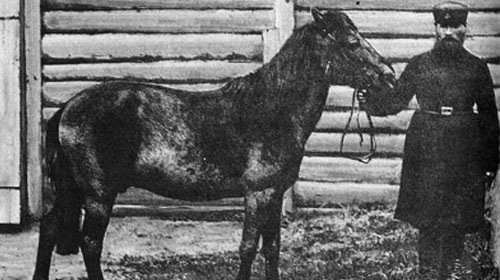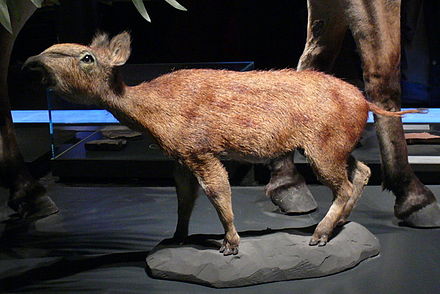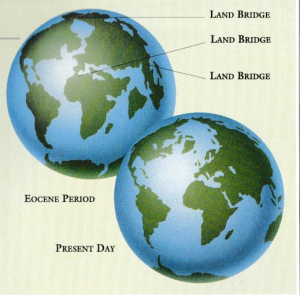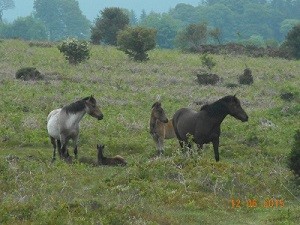The Dawn of the Horse
Some 60 million years ago the first horse-like creature roamed the Eocene forests of North America. Fossil evidence from Wyoming indicates that Eohippus, the Dawn Horse, was no bigger than a dog or fox and had four toes on the front feet and three on the hind. The ergot on modern horses is the remnant of the soft pad that formed behind the toes.
Through time, as the jungle environments transformed to more wooded scrub and then plains, the horse adapted to its environment, developing grazing teeth, a one toed hoof structure and a longer leg with a powerful leg ligament to control the hoof. About 6 million years ago, Pliohippus had many features of modern day equines and stood about 12 hands.
The “Grandfather” of the modern horse, Pliohippus, lived about 10-6 million years ago and gave rise Dinohippus, the closest relative of Equus Caballus, wild Asses and Zebras.
These ancestral horses spread from North America over land bridges to Europe and Asia. As the glaciers melted at the close of the final ice age, about 9,000 years ago, the land bridges became submerged by the sea isolating the North
American horse from European and Asian populations. For unknown reasons, perhaps by changing climate and hunting
by early humans, the horse became extinct in North America about 8,000 years ago. It was not until the 16th century that the horse returned to the Americas, when introduced by the Spanish.
Wild Horse Ancestors
Continuing to evolve in their respective environments across Europe and Asia, most modern horse breeds are generally attributed to several important ancestral populations. The European Forest Horse was a heavy framed animal that inhabited European marshes and gave rise to the Warmblood and some draft horse types. The Asian Wild Horse exists today as the famed Przewalski Horse of the Central Asian steppes. However Western Asian horses are thought to underpin today’s Arab types.

Other light horse stock is largely attributed to the Tarpan of the southern Russian steppes which unfortunately became extinct in the late 1800’s. The last wild Tarpan mare died in 1880 in the Ukraine but a semi-wild herd bred back from the Konic Horse, a Tarpan-related stock, exists in forest reserves in Poland. While not exactly a Tarpan, these horses have some of Tarpan characteristics such as the grullo colour. These back-bred stock are sometimes known as Heck Horses after the German Nazi director of the Berlin Zoo, Lutz Heck, who was involved in some of the re-breeding.
Domestication
There are differences of opinion as to what domestication means which has bearing on the published dates of horse domestication. To some researchers, domestication means that humans control their behaviour; to others it means that humans bred horses.
The earliest evidence for horse (Equus caballus) domestication has been found at the site of Krasni Yar, Kazakhstan, where remnants of a horse corral dating to 5600 years ago were identified. At this site, remains of a village of the Botai people include equine bones, leather harnesses and bridles, evidence of horse dung in buildings, and traces of horse milk fats in ceramics indicating that the Botai milked horses.
Other sites in Kazakstan and the Central Steppes have been found with evidence of horse domestication and it is generally believed that the domestic use of the horse spread from this area.
Initially, horses were raised for food and it appears, largely from DNA evidence, that only mares were kept and allowed to breed with wild stallions.
As domestication spread, the use of the horse for transport became more evident. Sites on the steppes southeast of the Ural Mountains, dating from around 2000 years ago, uncovered 16 graves containing the remains of chariots and horse bones and many other site have recovered remains of various equipment used to handle and control the horse.
From these early beginnings the use of the horse continued to evolve to the point where few undomesticated wild populations exist today. The horse has been used for transport, hunting, agriculture, military and police operations, exploration, haulage, and recreation.
The importance of the horse to human existence is the reason that essentially all modern horses are considered domesticated. It is equally because of human activity that large populations of wild horses, originally from domestic stock, exist.
Back to the Wild
As technology advanced and machines were used to transport people and things, plough the land, assist in battle and so on, the horse’s use in the human world diminished. Increasingly, farmers and ranchers and the military let their horses go rather than spend time and money to feed them. If a horses were needed, they were mustered from the wild.
Many horses, however, were left to survive in the wild and through generations adapted to an undomesticated wild environment. Australian Brumbies, for example, inhabit a variety of environments from relatively flat desert areas to forested mountain terrains. Despite the historical bloodlines that would, in a domestic setting, present a certain type, changes have been observed in by those who regularly interact or study Brumbies.
Mountain Brumbies such as seen in Kosciuszko National Park are evolving to have sloping shoulders, shorter necks and backs which in turn strengthens their skeletal frame and increases mobility. Adult Kosciuszko Brumbies are overall smaller and shorter in height that their likely bloodlines would, in a domestic situation, produce. The smaller overall frame enables Brumbies to survive on less food intake and the reduced peripheral circulation areas assist the Brumby to maintain effective body temperature in the cold weather.
In more recent times, horses (and other animals) have been deliberately returned to the wild. The concept of rewilding and conservation grazing have gained increasing acceptance as a way of bringing land back into balance with nature.
Rewilding
Rewilding is large-scale conservation aimed at restoring and protecting natural processes and core wilderness areas, providing connectivity between such areas, and protecting or reintroducing apex predators and keystone species. Rewilding projects may require ecological restoration or wilderness engineering, particularly to restore connectivity between fragmented protected areas, and reintroduction of predators where extirpated.
The word “rewilding” was coined by conservationist and activist Dave Foreman, one of the founders of the group Earth First!, who went on to help establish both the Wildlands Project (now the Wildlands Network) and the Rewilding Institute. The term first occurred in print in 1990 and was refined by conservation biologists Michael Soulé and Reed Noss in a paper published in 1998.

However, the concepts of rewilding were actually implemented earlier, in the 1980’s, when the Dutch government began introducing proxy species in the Oostvaardersplassen nature reserve in order to recreate a grassland ecology. In 2011 the Rewilding Europe initiative (https://www.rewildingeurope.com/) was established with the aim of rewilding 1 million hectares of land in the western Iberian Peninsula, Velebit, the Carpathians and the Danube Delta by 2020. Rewilding Europe’s working definition of Rewilding is:
Rewilding ensures natural processes and wild species to play a much more prominent role in the land- and seascapes, meaning that after initial support, nature is allowed to take more care of itself. Rewilding helps landscapes become wilder, whilst also providing opportunities for modern society to reconnect with such wilder places for the benefit of all life.
Rewilding Europe has several areas where wild horses have been, or are planned to be, introduced. Rewilding Europe asserts:
Humans exterminated the wild horse. Rewilding Europe is now helping to bring back the wild horse to where it once belonged, into the European landscapes, where it used to be a vital part of the ecosystem for hundreds of thousands of years. (https://www.rewildingeurope.com/rewilding-horses-in-europe/ )
Areas where wild horses have been re-introduced include: Western Iberia (Portugal), the Danube Delta, Velebit (Croatia), Central Apennines (Italy), the Oder Delta (Germany and Poland).
In recognition of the broader rewilding movement in Europe, Rewilding Europe has launched the Rewilding Europe Network .
Conservation Grazing
Conservation grazing is the use of semi-feral or domesticated grazing livestock to maintain and increase the biodiversity of natural or semi-natural grasslands, heathlands, wood pasture, wetlands and many other habitats. Conservation grazing is generally less intensive than practices such as prescribed burning, but still needs to be managed to ensure that overgrazing does not occur. The practice has proven to be beneficial in moderation in restoring and maintaining grassland and heathland ecosystems. The optimal level of grazing will depend on the goal of conservation, and different levels of grazing, alongside other conservation practices, can be used to induce the desired results.
The use of conservation grazing is dependent on what type of ecosystem, habitat, and plant community are desired to be maintained or restored. Grazing is a beneficial tool used to create a grass and small shrub dominated area.
Horses are being used for conservation grazing under the various rewilding efforts described previously but also in other situations, where protection of heath and grasslands is the main objective. Examples include the Dartmoor and Exmoor areas in Britain.









